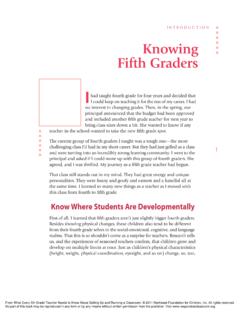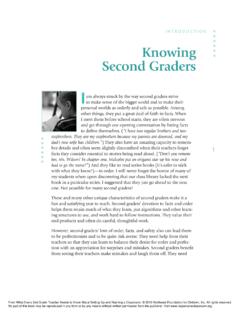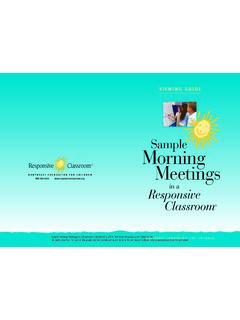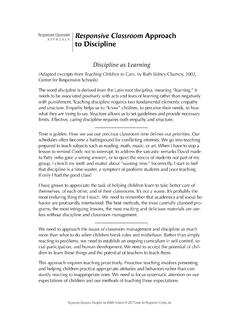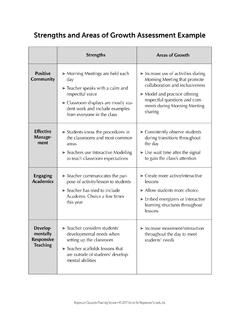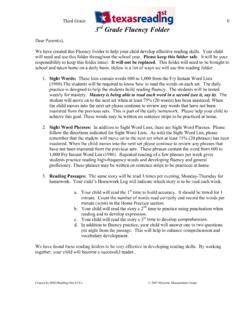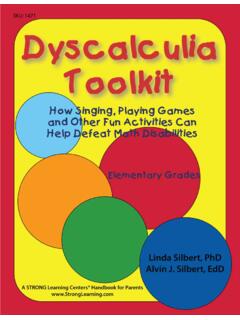Transcription of INTRODUCTION Knowing Fourth Graders
1 Graders are so alive! For good or bad, fourthgraders care deeply about almost everything that happens at school, and ambivalence is rare. When I taught this grade , I got used to students rushing down the hallways from the bus in the morning. They would unload their backpacks and coats in a frenzy (often dropping them unintentionally on the floor in their hurry), push through the door, and rush to the schedule posted on the wall. Even well into theyear, they d comment on the day with exclamations of delight and pangs of anguish. Yes! We have PE today! one student would exclaim while high-fiving a buddy. Hey, no fair! You said we were going to get to work on ourscience projects today! We have an assembly later?
2 What s it about? Do we have to go? What if it s boring? I can never see at those things! Whether expressed as joy or anxiety, emotional intensity is a hallmark offourth Graders . Exclamation marks seem to pepper their language. Schoolgoes best for them when teachers respond to their intensity with a consis-tent, relaxed, and light-hearted approach. Teaching Fourth Graders is aboutcreating a safe and comfortable classroom climate so that students feel secure enough to relax and take academic goal in writing this book is to provide you with the essentials of settingup and running a Fourth grade classroom so that your teaching and yourstudents learning can be joyful and rigorous. You ll find information oneverything from arranging classroom furniture to planning and teachinglunch and recess routines, from building community to engaging parents in classroom life.
3 Whether you re new to teaching or an experienced teacherswitching to Fourth grade , you ll find helpful information and advice aboutteaching this grade with N T R O D U C T I O NKnowingFourth GradersFrom What Every 4th grade Teacher Needs to Know About Setting Up and Running a Classroom. 2010 Northeast Foundation for Children, Inc. All rights reserved. No part of this book may be reproduced in any form or by any means without written permission from the publisher. Visit Where Students Are developmentallyAs educators know from researchers and their own classroom observations,children s growth and development follow certain patterns. Just as children sheight, weight, and physical abilities change, so do things such as their atten-tion span, their sense of humor, their tendency to prefer large or small groupsin social settings, and their sensitivities to change, risk taking, and friendshipchallenges.
4 Knowing our students in these areas that so deeply impact theirlearning is fundamental to teaching them well. When we design classrooms,lessons, curricular projects, and routines according to our knowledge of stu-dents strengths and needs, we create classrooms that allow students to bemore successful, both socially and remember my first year teaching Fourth grade . I knew that we were supposedto practice multiplication facts as part of our math work, so I set up a systemof weekly Friday math quizzes. I started to pressure the students to study mathfacts as part of their nightly homework so they could do well on Friday. As theyear went on, I noticed that some students seemed to be getting more andmore anxious. Friday mornings were pure torture for the students who, try asthey might, just couldn t memorize the toughest facts.
5 (You know the ones:7x6, 7x8, 6x8, 4x8, etc.) Not only that, but an alarming number of studentsstarted to exclaim, Oh! I hate math! I m so stupid! That ultimately pushedme to drop the weekly quizzes and stop the math fact wasn t until a couple of years later that I learned, from reading, talking to colleagues, and attending teacher workshops, to think about where stu-dents are developmentally when trying to understand their classroom behav-ior. I picked up practicalstrategies for adjusting myteaching to match theirstrengths and many aha momentsas I gained some answersto why my earlierto teaching math factsdidn t work for many2 When we design classrooms, lessons, curricular projects, and routines accordingto our knowledge of students strengthsand needs, we create classrooms that allow students to be more successful, both socially and What Every 4th grade Teacher Needs to Know About Setting Up and Running a Classroom.
6 2010 Northeast Foundation for Children, Inc. All rights reserved. No part of this book may be reproduced in any form or by any means without written permission from the publisher. Visit Graders . I learned thatfourth Graders tend to be self-critical and intense. Thoughthey can enjoy competition,the pressure of intense testingand too-high expectationscan defeat them. No wonderthere were so many tears! With this realization, Ichanged my approach. I hadthe class play games that helped them practice math facts. All students alsokept personal multiplication charts in their math books so they could referto them as they worked on longer multiplication and division problems. Igave an occasional fact quiz to check and see how we re doing as a class, but the pressure was low.
7 Not surprisingly, some students still masteredtheir facts easily, while others struggled. However, the stress level in the classwas much lower. Best of all, I no longer heard students saying they were nogood at math simply because they couldn t remember a few math facts!Common Characteristics of Fourth GradersAs that last story about math facts illustrates, one of the most commonlyrecognized characteristics of Fourth Graders is their intensity and inclinationto be self-critical. Fourth Graders tend to be sensitive, industrious, curious,and serious about fairness and justice. It s not uncommon to see a group offourth Graders on the playground spending more than half of their recesstime arguing about who gets to pitch in kickball or whether someone wasfouled in basketball.
8 The table on pages 5 and 6 details some of the common characteristics offourth Graders . As you use this table, keep these points in mind: Human development is scientists who study it do not yet fully agree on the means by which humans grow socially, emotionally,linguistically, or cognitively. Most theorists describe the process as involv-ing a dynamic interaction between a person s biological disposition andmany other environmental factors from the historical era in which a3 From What Every 4th grade Teacher Needs to Know About Setting Up and Running a Classroom. 2010 Northeast Foundation for Children, Inc. All rights reserved. No part of this book may be reproduced in any form or by any means without written permission from the publisher.
9 Visit grows up, to the person s culture, family, and the institutions he or she encounters (like schools, churches, and the media). The tableis not intended to ignore this complexity but instead to offer you a bridgebetween theory and the reality of classroom teaching. Every child is a result of the complex and dynamic process of development, no two children not even identical twins with the samegenetic make-up will develop in the same way or at the same rate. Also,within a given child , one area may develop at a much faster rate than an-other. For example, a particular Fourth grader might display the readingand writing abilities typical of most Fourth Graders while being relaxedand easy going when working through conflicts on the playground, a traitmore common in fifth Graders .
10 The table gives you a practical frame of lets you preparefor Fourth Graders and have a resource if something puzzling comes example, you may notice that many students are melting down during competitive games. This is pretty common in most of the fourthgrade year, so you may want to adjust the games to deemphasize com-petition, Knowing that students will probably be better able to handlecompetition at the end of the year or in fifth grade . The table is not about what s normal. It s not intended to limit yourthinking about students potential, to help you make decisions aboutwhether a student is normal, or to lead you to ignore the needs of students who differ from other Fourth Graders . For example, althoughmany Fourth Graders can be socially anxious, some thrive on getting upin front of others to perform skits or present research projects.

